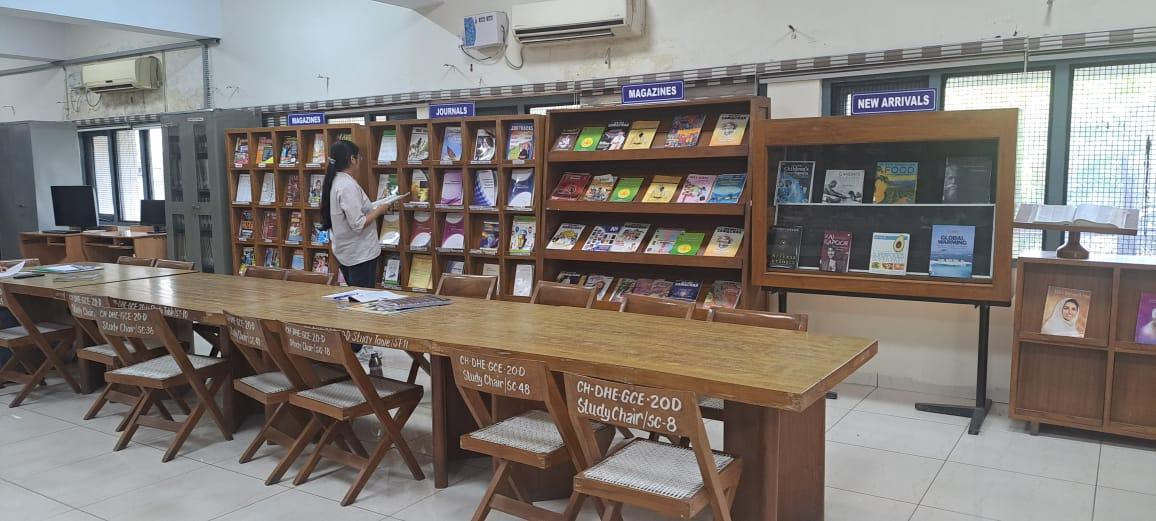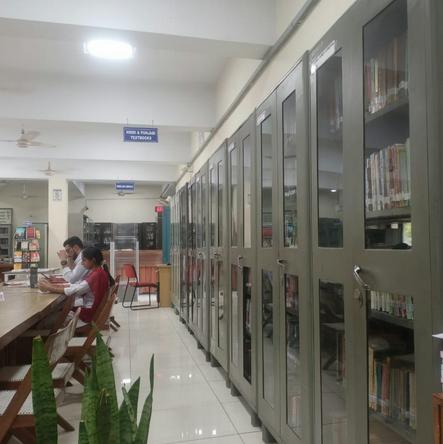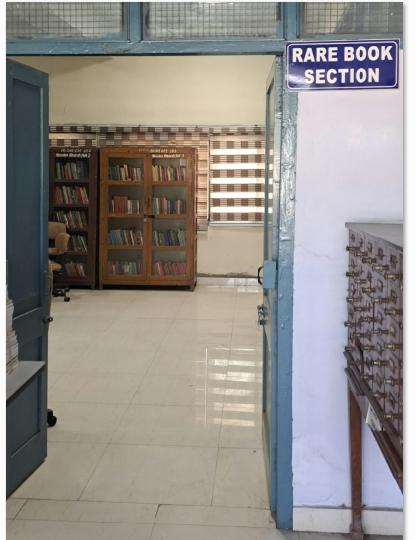GOVT. COLLEGE OF EDUCATION SECTOR-20D CHANDIGARH
ABOUT LIBRARY:
The college library serves as a sacred haven for the learning process. It nurtures lifelong intellectual growth and personal fulfilment by offering versatile access to essential information resources for all users. Additionally, it encourages the sharing of ideas among individuals, promotes a love for reading, and contributes to social enlightenment within our knowledge-driven society. The library functions as the central information resource hub and repository for both printed and electronic materials, supporting teaching and research activities at the institute.
Collection:-
The library prides itself on housing an extensive collection of 43,940 books, which includes an array of Reference materials, Encyclopedias, Dictionaries, Dissertations, Handbooks, Surveys, and more.
In addition to its remarkable book collection, the library provides access to a diverse range of academic content through its subscriptions, which include 17 journals, 26 magazines, and 11 newspapers. This commitment to staying current with information resources underscores the library's dedication to supporting the educational and research needs of its patrons.
Library Automation:-
Library is fully computerized with 7 computers and is linked through LAN. Web Centric LSEase centric software has been installed for library operations. In addition to computerized Issue/Return of books to students, Barcodes, Spine labels, Catalogue cards and Library cum Identity card (SMART CARDS) are generated through Libsys software. Library provides OPAC and internet services to staff and students.
Consortia:
The library has taken a progressive approach to offer e-books and e-journals by subscribing to the 'National Library and Information Services Infrastructure for Scholarly Content (N-LIST) programme of INFLIBNET.' N-LIST is the college component of e-Shodh Sindhu. Users can have access to more than 66000 e- journals and 3164309 e-books from anywhere using user –name and password.
The library is a member of N-List consortia of Information library network (INFLIBNET). This program, under the Ministry of HRD and the UGC of India, is autonomous and serves college faculty and all the students of the college including B.Ed, M.Ed and PGDG&C students. Through this initiative, users gain access to a vast repository of over 6,000 electronic journals and 60,000 e-books, accessible from anywhere using a user-name and password.
Library operations have been modernized and automated through the implementation of web-centric software, utilizing the latest version available. The Online Public Access Catalogue (OPAC), which is publicly accessible, empowers users to search for documents within the library's holdings efficiently.
To facilitate access to e-resources, a dedicated section within the library has been established, allowing users to explore e-books, e-contents, and e-journals seamlessly.
Building/Structure:
The library building comprises two floors. On the ground floor, you will find the Circulation Section, the Periodical Section, and the Stack area. Moving to the first floor, you'll encounter the Reference Section, the Rare Book Section, and the Book Bank Section. This layout is designed to provide efficient access to various library services and collections for our users..
Services:
The college library operates on an open access system, making its resources readily accessible to both students and staff.
It provides a comprehensive array of information services, including reference assistance, bibliographic support, current awareness updates, orientation sessions, and reprographic services, among others.
Additionally, the library extends a Book Bank facility to assist students in need.
As part of its commitment to promoting library resource utilization, the library organizes various competitions on an annual basis to motivate and engage students with its valuable resources.
Book Bank Facility:-
Under the scheme of University Grants Commission for Text Book Library, complete sets of Text Books are issued to the needy students for the entire semester.
Additionally, SC/ST grants are made available to B.Ed and M.Ed students every year
Library RFID Solution:
Library has implemented RFID (Radio-Frequency Identification) solution for the ease of library users in issue-return, faster and accurate transactions and enhanced security of the library holdings.
GOVT. COLLEGE OF EDUCATION SECTOR-20D CHANDIGARH
Building/Structure
The library building comprises two floors.
Entrance of the Library and Property counter:-
At the entrance of the college library, you will find a designated Property Counter where students can securely deposit their belongings that are not permitted inside the library.

GROUND FLOOR
On the ground floor, you will find the Circulation Section, the Periodical Section, and the Textbook section &Stack area.
Circulation section:-
The Circulation Section serves as the hub for the entire process of book lending and returning. It plays a pivotal role in providing services to all bona fide college students who receive their Identity cum Library Cards from this section. These cards enable students to borrow materials, manage due dates, and ensure a smooth and efficient circulation process for all library users.


Periodical section:-
The Periodical Section offers a diverse array of journals, encompassing a wide range of topics. The library subscribes to a total of 17 journals, 11 newspapers, and 25 magazines, providing students and faculty with access to an extensive collection of current and informative publications. This section serves as a valuable resource for staying updated on various subjects and keeping abreast of the latest developments across a broad spectrum of interests.


& Stack Area:
Textbook section is well maintained with two and more copies of the books prescribed for various courses. Stack area is an extensive collection of approximately 25,000 books, spanning a wide range of subjects like Psychology, books on guidance & counselling , Pedagogy books, Books on Education subject, General books, Fiction, New arrival books etc. Furthermore, Section boasts a dedicated Dissertation area, where the generous contributions of M.Ed. students are showcased each year.
In addition to these features, the Stack area is designed for open access, making it easy for readers to browse and access materials freely, enhancing the overall user experience within the library.


Textbook section &Stack Area
FIRST FLOOR
The first floor of the library houses the Reference Section, the Rare Book Section, and the Book Bank Section. . Additionally, this floor serves as a repository for hardbound journals and magazines that the library subscribes to, preserving a wealth of valuable historical and contemporary knowledge.
Reference section:-
The Reference section of this library boasts an extensive collection of resources, including encyclopedias, dictionaries, bibliographies, and competitive exam preparation books, catering to the diverse needs of students. Located on the first floor, this section offers a comprehensive range of services at the Reference Desk and provides a quiet and conducive Reading Hall for research scholars and dedicated readers.

Rare book section:-
The library boasts a remarkable collection of approximately 877 rare books, featuring works on prominent figures such as Mahatma Gandhi Ji, Pt. Jawaharlal Nehru, Indira Gandhi, freedom fighters, and foreign authors, among others.

Book Bank Section:-
At the beginning of each academic session, the library extends the Book Bank facility to support students in need, specifically those enrolled in B.Ed and M.Ed programs. This facility provides them with access to the required textbooks for the entire semester, ensuring that essential learning materials are readily available to aid in their studies.

GOVT. COLLEGE OF EDUCATION SECTOR-20D CHANDIGARH
LIBRARY RULES:
- Books can be borrowed for a maximum period of 14 days.
- Members who borrow books from the library must return them within 14 days.
- An overdue charge of Rs. 1.00/- per day will be applied for books kept beyond their due date.
- In case of a lost library ticket, it should be reported immediately to the librarian. A duplicate ticket can be issued upon payment of Rs. 10/- .
- Any damage to books must be reported to the librarian before borrowing. Failure to do so may result in the student being held responsible for the damage.
- If a borrower fails to replace a lost or damaged book within one month from the due date of its return, they shall be required to pay the full cost of the book to the library.
- Borrowers are responsible for replacing any lost, damaged, or otherwise compromised books. In the case of a set of volumes, the price for the entire set will be charged.
- Upon admission to the college, students will be issued an Identity cum Library Card upon presentation of the fee receipt.
- Students must carry their Identity Card/Library card when visiting the library. Failure to produce the card upon request may result in the student being denied entry to the library.
- Personal belongings are not allowed in the library.
Library Collection Not Available for Borrowing:
The following categories of books, journals, etc., shall not be available for borrowing from the library:
- Books designated as Reference materials by the Library.
- Rare books and manuscripts.
- Journals and Magazines, among others.
In exceptional cases, the librarian, at their discretion, may permit the borrowing of a reference book for a limited duration.
GOVT. COLLEGE OF EDUCATION SECTOR-20D CHANDIGARH
Link to Online Resources for faculty and Students:-
Name of resources |
Link of websites |
N-List |
|
National digital library of India |
|
DOAJ |
|
ShodhGanga for Dissertation |
|
ShodhGangotri for Synopsis |
|
Open Access Journals |
|
Free E-books |
|
SwyamPrabha |
|
Download Pdf of free e-books |
|
E-books |
|
NCERTE-books and publications |
|
EBSCO |
|
Computer E-books |
|
e-PG Pathshala |
|
E-GyanKosh |
|
VIDWAN Expert Database &National Research Network |
GOVT. COLLEGE OF EDUCATION SECTOR-20D CHANDIGARH
LIST OF JOURNALS ACQUIRED BY THE COLLEGE LIBRARY
- ARTHASHASTRA INDIAN JOURNAL OF ECONOMICS RESEARCH
- CURRENT SCIENCE
- DOWN TO EARTH
- EAST & WEST SERIES JOURNAL
- EDUCATION OF YOGA
- EDUTRACKS
- INTERNATIONAL JOURNAL OF INFORMATION & LIBRARIES
- INTERNATIONAL JOURNAL OF INFORMATION LIBRARY AND SOCIETY
- INTERNATIONAL JOURNAL OF KNOWLEDGE MANAGEMENT AND PRACTICES
- JOURNAL OF EDUCATIONAL TECHNOLOGY
- JOURNAL OF EDUCATIONAL PSYCHOLOGY
- JOURNAL OF ENGLISH LANGUAGE TEACHING
- JOURNAL OF SCHOOL EDUCATIONAL TECHNOLOGY
- JOURNAL OF EDUCATIONAL &PSYCHOLOGICAL RESEARCH
- MIRACLE OF TEACHING
- RESONANCE (JOURNAL OF SCIENCE EDUCATION)
- UNIVERSITY NEWS
LIST OF MAGAZINES ACQUIRED BY THE COLLEGE LIBRARY
- CHAMPAK (Monthly)
- CHRONICLE (Monthly)
- COMPETITION REFRESHER (Monthly)
- COMPETITION SUCCESS REVIEW (Monthly)
- DIGIT (Monthly)
- ECONOMIC & POLITICAL WEEKLY
- EMPLOYMENT NEWS
- FEMINA
- FRONTLINE
- G.K. TODAY (Monthly)
- INDIA TODAY
- OUTLOOK
- PRATIYOGITA DARPAN (Monthly)
- READER’S DIGEST (Monthly)
- SEMINAR (Monthly)
- SPORTS STAR
- TIME
- YOJANA
- GRAH SOBHA
- NAVNEET
- PRATIYOGITA DARPAN
- SAKHI
- SARITA
- YOJANA
- PREET LARI
- SIRJANA
LIST OF NEWSPAPER ACQUIRED BY THE COLLEGE LIBRARY
Kindly click on the following link of library for more details:-
Ledger Pages 2022 https://gcelibref.weebly.com Ledger Pages Library at a glance http://192.168.1.190:8380/opac/browse/browse.html Ledger Pages 2021-22